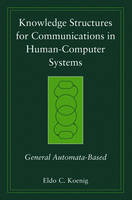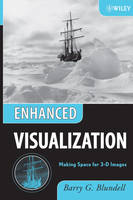Knowledge Structures for Communications in Human-Computer Systems
 -15%
portes grátis
-15%
portes grátis
Knowledge Structures for Communications in Human-Computer Systems
General Automata-Based
Koenig, Eldo C.
John Wiley & Sons Inc
11/2006
296
Mole
Inglês
9780471998136
15 a 20 dias
448
Descrição não disponível.
Preface. 1. Introduction.
1.1 Considerations for Establishing Knowledge Structures for Computers.
1.2 Knowledge About Automata as a Subset of World Knowledge.
1.2.1 General Automata.
1.2.2 Extracting and Storing the Meanings of Sentences.
1.2.3 Associating Knowledge.
1.2.4 Establishing Conclusions and Inferences.
Exercises.
2. A General Automaton.
2.1 Formal Analysis for a General Automaton.
2.1.1 General Analysis.
2.1.2 Graph Model.
2.1.3 Select Properties of the Graph Model.
2.2 An Application of the Disciplines to the Modeling of Natural Automata.
2.2.1 A Case Study.
2.2.2 Required State Changes.
2.2.3 Algorithm for Determining Required State Changes.
Exercises.
3. A General Automaton: Detailed Analysis.
3.1 Distinguishable Receptors and Effectors.
3.2 Nonhomogeneous Environments.
3.3 Transformation Response Components.
3.4 Nonshared Environments Interpreted as Distinguishable.
3.4.1 Model for Performance in Both Shared and Nonshared Environments.
3.4.2 Model for Performance in Shared Environments.
Exercises.
4. Processing of Knowledge About Automata.
4.1 Formulation of a Language Information Theory.
4.1.1 Class 1 Sentence.
4.1.2 Class 2 Sentence.
4.1.3 Class 3 Sentence.
4.1.4 Class 4 Sentence.
4.1.5 Class 5 Sentence.
4.1.6 Class 6 Sentence.
4.1.7 Class 7 Sentence.
4.2 Extracting and Storing the Meaning of Sentences by Computer.
4.2.1 Description of an Algorithm.
4.3 Knowledge Association.
4.3.1 Association by Combining Graphs Through Common Points.
4.3.2 Associations by Combining Graph (n + 1)-Tuples.
4.3.3 Computer Methods for Association of Knowledge.
4.4 Deductive Processes.
4.4.1 Deductive Processes Related to Association Through Common Points.
4.4.2 Deductive Processes Related to Association by Combining Graph Tuples.
4.4.3 Deductive Processes with Aristotelian Form A as a Premise.
4.5 Inferences.
4.5.1 Inferences Related to a Single Graph Tuple of Associated Knowledge.
4.5.2 Inferences Related to More than One Graph Tuple of Associated Knowledge.
Exercises.
5. A General System of Interactive Automata.
5.1 Formal Analysis for a General System of Interactive Automata.
5.1.1 General Analysis.
5.1.2 Microsystem Model.
5.1.3 Macrosystem Model.
5.2 Example Applications.
5.2.1 A Two-Component System.
5.2.2 A System of Many Components.
Exercises.
6. Processing of Knowledge About Systems of Automata.
6.1 A General System of Interactive Automata: Detailed Analysis.
6.1.1 The Microsystem Model.
6.1.2 The Macrosystem Model.
6.2 Knowledge Structures for Sentences Describing Systems of Interactive Automata.
Exercises.
7. Changing Expressions of Knowledge for Communication from One Form and Style to Another.
7.1 Introduction.
7.2 Sets and Relations.
7.3 Establishing Open Expressions and Open Sentences.
7.4 Selecting Subsets of Open Expressions.
7.5 Applying the Results of the Above Analysis.
7.6 Summary and Conclusions.
Exercises.
8. Electronic Security Through Pseudo Languages.
8.1 Introduction.
8.2 Defi nitions, Sets, and Relations.
8.3 Analysis for E-Security Through Pseudo Languages.
8.3.1 A Basic E-Security System.
8.3.2 A Two-Step Encryption System.
8.3.3 E-Signing.
8.4 Summary and Conclusions.
Exercises.
Appendix A: Analysis for an Effective Operation of a General Automaton.
A.1 Introduction.
A.2 Recursive Methods.
A.3 Effective Operation Analysis.
Exercises.
Appendix B: Analysis for an Effective Operation of a General System of Interactive Automata.
B.1 Introduction.
B.2 Microsystem Graphs.
B.3 Macrosystem Graphs.
B.4 Example.
Exercises.
References.
Index.
1.1 Considerations for Establishing Knowledge Structures for Computers.
1.2 Knowledge About Automata as a Subset of World Knowledge.
1.2.1 General Automata.
1.2.2 Extracting and Storing the Meanings of Sentences.
1.2.3 Associating Knowledge.
1.2.4 Establishing Conclusions and Inferences.
Exercises.
2. A General Automaton.
2.1 Formal Analysis for a General Automaton.
2.1.1 General Analysis.
2.1.2 Graph Model.
2.1.3 Select Properties of the Graph Model.
2.2 An Application of the Disciplines to the Modeling of Natural Automata.
2.2.1 A Case Study.
2.2.2 Required State Changes.
2.2.3 Algorithm for Determining Required State Changes.
Exercises.
3. A General Automaton: Detailed Analysis.
3.1 Distinguishable Receptors and Effectors.
3.2 Nonhomogeneous Environments.
3.3 Transformation Response Components.
3.4 Nonshared Environments Interpreted as Distinguishable.
3.4.1 Model for Performance in Both Shared and Nonshared Environments.
3.4.2 Model for Performance in Shared Environments.
Exercises.
4. Processing of Knowledge About Automata.
4.1 Formulation of a Language Information Theory.
4.1.1 Class 1 Sentence.
4.1.2 Class 2 Sentence.
4.1.3 Class 3 Sentence.
4.1.4 Class 4 Sentence.
4.1.5 Class 5 Sentence.
4.1.6 Class 6 Sentence.
4.1.7 Class 7 Sentence.
4.2 Extracting and Storing the Meaning of Sentences by Computer.
4.2.1 Description of an Algorithm.
4.3 Knowledge Association.
4.3.1 Association by Combining Graphs Through Common Points.
4.3.2 Associations by Combining Graph (n + 1)-Tuples.
4.3.3 Computer Methods for Association of Knowledge.
4.4 Deductive Processes.
4.4.1 Deductive Processes Related to Association Through Common Points.
4.4.2 Deductive Processes Related to Association by Combining Graph Tuples.
4.4.3 Deductive Processes with Aristotelian Form A as a Premise.
4.5 Inferences.
4.5.1 Inferences Related to a Single Graph Tuple of Associated Knowledge.
4.5.2 Inferences Related to More than One Graph Tuple of Associated Knowledge.
Exercises.
5. A General System of Interactive Automata.
5.1 Formal Analysis for a General System of Interactive Automata.
5.1.1 General Analysis.
5.1.2 Microsystem Model.
5.1.3 Macrosystem Model.
5.2 Example Applications.
5.2.1 A Two-Component System.
5.2.2 A System of Many Components.
Exercises.
6. Processing of Knowledge About Systems of Automata.
6.1 A General System of Interactive Automata: Detailed Analysis.
6.1.1 The Microsystem Model.
6.1.2 The Macrosystem Model.
6.2 Knowledge Structures for Sentences Describing Systems of Interactive Automata.
Exercises.
7. Changing Expressions of Knowledge for Communication from One Form and Style to Another.
7.1 Introduction.
7.2 Sets and Relations.
7.3 Establishing Open Expressions and Open Sentences.
7.4 Selecting Subsets of Open Expressions.
7.5 Applying the Results of the Above Analysis.
7.6 Summary and Conclusions.
Exercises.
8. Electronic Security Through Pseudo Languages.
8.1 Introduction.
8.2 Defi nitions, Sets, and Relations.
8.3 Analysis for E-Security Through Pseudo Languages.
8.3.1 A Basic E-Security System.
8.3.2 A Two-Step Encryption System.
8.3.3 E-Signing.
8.4 Summary and Conclusions.
Exercises.
Appendix A: Analysis for an Effective Operation of a General Automaton.
A.1 Introduction.
A.2 Recursive Methods.
A.3 Effective Operation Analysis.
Exercises.
Appendix B: Analysis for an Effective Operation of a General System of Interactive Automata.
B.1 Introduction.
B.2 Microsystem Graphs.
B.3 Macrosystem Graphs.
B.4 Example.
Exercises.
References.
Index.
Este título pertence ao(s) assunto(s) indicados(s). Para ver outros títulos clique no assunto desejado.
communication; fundamentals; automata; comprehensive; general; humancomputer; extensive; koenigs; thirtyfour; presents; seminal; hcs; systems; knowledge structures; resource; engineering; model; representations
Preface. 1. Introduction.
1.1 Considerations for Establishing Knowledge Structures for Computers.
1.2 Knowledge About Automata as a Subset of World Knowledge.
1.2.1 General Automata.
1.2.2 Extracting and Storing the Meanings of Sentences.
1.2.3 Associating Knowledge.
1.2.4 Establishing Conclusions and Inferences.
Exercises.
2. A General Automaton.
2.1 Formal Analysis for a General Automaton.
2.1.1 General Analysis.
2.1.2 Graph Model.
2.1.3 Select Properties of the Graph Model.
2.2 An Application of the Disciplines to the Modeling of Natural Automata.
2.2.1 A Case Study.
2.2.2 Required State Changes.
2.2.3 Algorithm for Determining Required State Changes.
Exercises.
3. A General Automaton: Detailed Analysis.
3.1 Distinguishable Receptors and Effectors.
3.2 Nonhomogeneous Environments.
3.3 Transformation Response Components.
3.4 Nonshared Environments Interpreted as Distinguishable.
3.4.1 Model for Performance in Both Shared and Nonshared Environments.
3.4.2 Model for Performance in Shared Environments.
Exercises.
4. Processing of Knowledge About Automata.
4.1 Formulation of a Language Information Theory.
4.1.1 Class 1 Sentence.
4.1.2 Class 2 Sentence.
4.1.3 Class 3 Sentence.
4.1.4 Class 4 Sentence.
4.1.5 Class 5 Sentence.
4.1.6 Class 6 Sentence.
4.1.7 Class 7 Sentence.
4.2 Extracting and Storing the Meaning of Sentences by Computer.
4.2.1 Description of an Algorithm.
4.3 Knowledge Association.
4.3.1 Association by Combining Graphs Through Common Points.
4.3.2 Associations by Combining Graph (n + 1)-Tuples.
4.3.3 Computer Methods for Association of Knowledge.
4.4 Deductive Processes.
4.4.1 Deductive Processes Related to Association Through Common Points.
4.4.2 Deductive Processes Related to Association by Combining Graph Tuples.
4.4.3 Deductive Processes with Aristotelian Form A as a Premise.
4.5 Inferences.
4.5.1 Inferences Related to a Single Graph Tuple of Associated Knowledge.
4.5.2 Inferences Related to More than One Graph Tuple of Associated Knowledge.
Exercises.
5. A General System of Interactive Automata.
5.1 Formal Analysis for a General System of Interactive Automata.
5.1.1 General Analysis.
5.1.2 Microsystem Model.
5.1.3 Macrosystem Model.
5.2 Example Applications.
5.2.1 A Two-Component System.
5.2.2 A System of Many Components.
Exercises.
6. Processing of Knowledge About Systems of Automata.
6.1 A General System of Interactive Automata: Detailed Analysis.
6.1.1 The Microsystem Model.
6.1.2 The Macrosystem Model.
6.2 Knowledge Structures for Sentences Describing Systems of Interactive Automata.
Exercises.
7. Changing Expressions of Knowledge for Communication from One Form and Style to Another.
7.1 Introduction.
7.2 Sets and Relations.
7.3 Establishing Open Expressions and Open Sentences.
7.4 Selecting Subsets of Open Expressions.
7.5 Applying the Results of the Above Analysis.
7.6 Summary and Conclusions.
Exercises.
8. Electronic Security Through Pseudo Languages.
8.1 Introduction.
8.2 Defi nitions, Sets, and Relations.
8.3 Analysis for E-Security Through Pseudo Languages.
8.3.1 A Basic E-Security System.
8.3.2 A Two-Step Encryption System.
8.3.3 E-Signing.
8.4 Summary and Conclusions.
Exercises.
Appendix A: Analysis for an Effective Operation of a General Automaton.
A.1 Introduction.
A.2 Recursive Methods.
A.3 Effective Operation Analysis.
Exercises.
Appendix B: Analysis for an Effective Operation of a General System of Interactive Automata.
B.1 Introduction.
B.2 Microsystem Graphs.
B.3 Macrosystem Graphs.
B.4 Example.
Exercises.
References.
Index.
1.1 Considerations for Establishing Knowledge Structures for Computers.
1.2 Knowledge About Automata as a Subset of World Knowledge.
1.2.1 General Automata.
1.2.2 Extracting and Storing the Meanings of Sentences.
1.2.3 Associating Knowledge.
1.2.4 Establishing Conclusions and Inferences.
Exercises.
2. A General Automaton.
2.1 Formal Analysis for a General Automaton.
2.1.1 General Analysis.
2.1.2 Graph Model.
2.1.3 Select Properties of the Graph Model.
2.2 An Application of the Disciplines to the Modeling of Natural Automata.
2.2.1 A Case Study.
2.2.2 Required State Changes.
2.2.3 Algorithm for Determining Required State Changes.
Exercises.
3. A General Automaton: Detailed Analysis.
3.1 Distinguishable Receptors and Effectors.
3.2 Nonhomogeneous Environments.
3.3 Transformation Response Components.
3.4 Nonshared Environments Interpreted as Distinguishable.
3.4.1 Model for Performance in Both Shared and Nonshared Environments.
3.4.2 Model for Performance in Shared Environments.
Exercises.
4. Processing of Knowledge About Automata.
4.1 Formulation of a Language Information Theory.
4.1.1 Class 1 Sentence.
4.1.2 Class 2 Sentence.
4.1.3 Class 3 Sentence.
4.1.4 Class 4 Sentence.
4.1.5 Class 5 Sentence.
4.1.6 Class 6 Sentence.
4.1.7 Class 7 Sentence.
4.2 Extracting and Storing the Meaning of Sentences by Computer.
4.2.1 Description of an Algorithm.
4.3 Knowledge Association.
4.3.1 Association by Combining Graphs Through Common Points.
4.3.2 Associations by Combining Graph (n + 1)-Tuples.
4.3.3 Computer Methods for Association of Knowledge.
4.4 Deductive Processes.
4.4.1 Deductive Processes Related to Association Through Common Points.
4.4.2 Deductive Processes Related to Association by Combining Graph Tuples.
4.4.3 Deductive Processes with Aristotelian Form A as a Premise.
4.5 Inferences.
4.5.1 Inferences Related to a Single Graph Tuple of Associated Knowledge.
4.5.2 Inferences Related to More than One Graph Tuple of Associated Knowledge.
Exercises.
5. A General System of Interactive Automata.
5.1 Formal Analysis for a General System of Interactive Automata.
5.1.1 General Analysis.
5.1.2 Microsystem Model.
5.1.3 Macrosystem Model.
5.2 Example Applications.
5.2.1 A Two-Component System.
5.2.2 A System of Many Components.
Exercises.
6. Processing of Knowledge About Systems of Automata.
6.1 A General System of Interactive Automata: Detailed Analysis.
6.1.1 The Microsystem Model.
6.1.2 The Macrosystem Model.
6.2 Knowledge Structures for Sentences Describing Systems of Interactive Automata.
Exercises.
7. Changing Expressions of Knowledge for Communication from One Form and Style to Another.
7.1 Introduction.
7.2 Sets and Relations.
7.3 Establishing Open Expressions and Open Sentences.
7.4 Selecting Subsets of Open Expressions.
7.5 Applying the Results of the Above Analysis.
7.6 Summary and Conclusions.
Exercises.
8. Electronic Security Through Pseudo Languages.
8.1 Introduction.
8.2 Defi nitions, Sets, and Relations.
8.3 Analysis for E-Security Through Pseudo Languages.
8.3.1 A Basic E-Security System.
8.3.2 A Two-Step Encryption System.
8.3.3 E-Signing.
8.4 Summary and Conclusions.
Exercises.
Appendix A: Analysis for an Effective Operation of a General Automaton.
A.1 Introduction.
A.2 Recursive Methods.
A.3 Effective Operation Analysis.
Exercises.
Appendix B: Analysis for an Effective Operation of a General System of Interactive Automata.
B.1 Introduction.
B.2 Microsystem Graphs.
B.3 Macrosystem Graphs.
B.4 Example.
Exercises.
References.
Index.
Este título pertence ao(s) assunto(s) indicados(s). Para ver outros títulos clique no assunto desejado.




